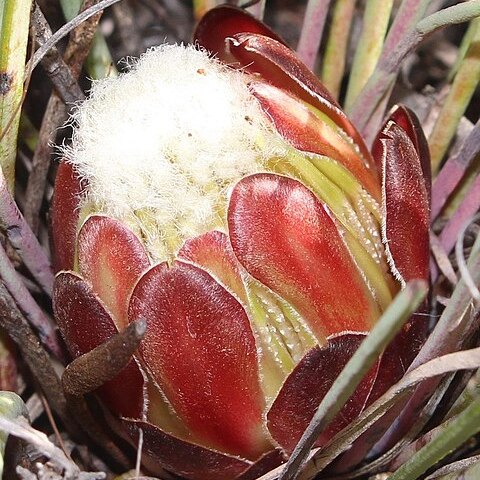A dwarf, tufted shrublet forming dense clumps 0.3-0.6 m in diameter, up to 0.3 m in height. Branches short, subterranean, dichotomous, terminal branchlets bearing alternately arranged, glabrous, lanceolate to ovate scales. Leaves acicular canaliculate to linear, 150-400 mm long and 2-5 mm wide, glabrous except for a few slender trichomes in the petiolar region, occasionally slightly glaucous, smooth to slightly scabrous, apex acute to mucronate. Inflorescence globose cyathiform, 20-50 mm in diameter. Involucral receptacle 10-15 mm in diameter, flat. Involucral bracts 4-5 seriate; inner series oblong-spathulate, 20-25 mm long, 10 mm wide; apices broadly obtuse, slightly concave; outer series broadly ovate, 10-15 mm long; 10-15 mm wide; outer surface of bracts minutely and sparsely sericeous soon becoming glabrous, margins minutely ciliate; greenish, flushed with dull carmine, becoming uniformly carmine with age. Perianth 25-30 mm long, glabrous except for the densely lanate apices of the perianth limbs. Adaxial perianth sheath 4 mm wide proximally, tapering to filiform below the perianth limbs, margins undulate and involute; limbs linear acuminate, 7-9 mm long, glabrous for the greater part of their length except for the densely lanate apices; median adaxial limb shorter than the remainder. Anthers 4.5 mm long, linear. Style adaxially arcuate 25-30 mm long, tapering subterminally, slightly quadrangular, compressed, glabrous. Pollen presenter narrowly linear to filiform, flattened, 5-6 mm long, longitudinally grooved. Hypogynous scales ovate-acute to irregularly oblong, retuse to bifid, 1.5 mm long. Flowering commences in September and continues until November.
More
Dwarf shrub, lignotuberous, subterranean stems with brown scales, 0.2-0.3 m high. Leaves petiolate, needle-like to linear, 150-400 x 2-5 mm, smooth to slightly scabrous, coriaceous, hairless. Flower head globose, cyathiform, 20-50 mm in diam. Involucral bracts 4-or 5-seriate; outer series ovate, obtuse, 10-15 x 10-15 mm, green, becoming carmine with age, fine hairs on outer surface; inner series oblong-spathulate, obtuse, 20-25 x 10 mm. Flowers: perianth white, 25-30 mm long, straight, tube 8-10 mm long, glabrous, tips with white-woolly hairs; style 25-30 mm long, curved inwards; pollen presenter 5-6 mm long, linear. Flowering time Sept.-Nov.
Like P. vogtsiae but leaves linear to needle-like.


